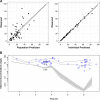Optimizing Meropenem in Highly Resistant Klebsiella pneumoniae Environments: Population Pharmacokinetics and Dosing Simulations in Critically Ill Patients
- PMID: 36197095
- PMCID: PMC9664861
- DOI: 10.1128/aac.00321-22
Optimizing Meropenem in Highly Resistant Klebsiella pneumoniae Environments: Population Pharmacokinetics and Dosing Simulations in Critically Ill Patients
Abstract
Critically ill patients are characterized by substantial pathophysiological changes that alter the pharmacokinetics (PK) of hydrophilic antibiotics, including carbapenems. Meropenem is a key antibiotic for multidrug-resistant Gram-negative bacilli, and such pathophysiological alterations can worsen treatment outcomes. This study aimed to determine the population PK of meropenem and to propose optimized dosing regimens for the treatment of multidrug-resistant Klebsiella pneumoniae in critically ill patients. Two plasma samples were collected from eligible patients over a dosing interval. Nonparametric population PK modeling was performed using Pmetrics. Monte Carlo simulations were applied to different dosing regimens to determine the probability of target attainment and the cumulative fraction of response, taking into account the local MIC distribution for K. pneumoniae. The targets of 40% and 100% for the fraction of time that free drug concentrations remained above the MIC (ƒT>MIC) were tested, as suggested for critically ill patients. A one-compartment PK model using data from 27 patients showed high interindividual variability. Significant PK covariates were the 8-h creatinine clearance for meropenem and the presence of an indwelling catheter for pleural, abdominal, or cerebrospinal fluid drainage for the meropenem volume of distribution. The target 100% ƒT>MIC for K. pneumoniae, with a MIC of ≤2 mg/liter, could be attained by the use of a continuous infusion of 2.0 g/day. Meropenem therapy in critically ill patients could be optimized for K. pneumoniae isolates with an MIC of ≤2 mg/liter by using a continuous infusion in settings with more than 50% isolates have a MIC of ≥32mg/L.
Keywords: Klebsiella pneumoniae; critically ill; dose optimization; meropenem.
Conflict of interest statement
The authors declare no conflict of interest.
Figures




References
-
- Nguyen TNT, Nguyen PLN, Le NTQ, Nguyen LPH, Duong TB, Ho NDT, Nguyen QPN, Pham TD, Tran AT, The HC, Nguyen HH, Nguyen CVV, Thwaites GE, Rabaa MA, Pham DT. 2021. Emerging carbapenem-resistant Klebsiella pneumoniae sequence type 16 causing multiple outbreaks in a tertiary hospital in southern Vietnam. Microb Genom 7. 10.1099/mgen.0.000519. - DOI - PMC - PubMed
Publication types
MeSH terms
Substances
LinkOut - more resources
Full Text Sources

